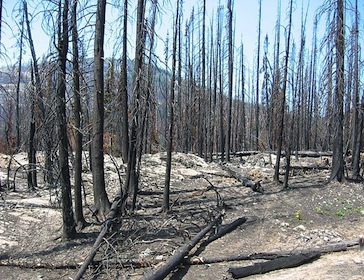 By Tim Radford
By Tim Radford
Climate News Network
Climate scientists may have to rethink some of their old assumptions about carbon. U.S. and European researchers have just established that black carbon, soot and biochar – the burnt remains from countless forest fires – doesn’t stay in the soil indefinitely.
Around 27 million tons of the stuff gets dissolved in water and washed down the rivers into the oceans each year.
Black carbon or biochar has been hailed as one possible way of limiting greenhouse gas emissions, by taking carbon out of circulation. But this study, according to a report in the journal Science, “closes a major gap in the global charcoal budget and provides critical information in the context of geo-engineering.”
Forest, bush, scrub and peat fires produce somewhere between 40 and 250 million tons of black carbon every year. Had this burning been complete, this would have ended up as carbon dioxide, back in the atmosphere.
So researchers have counted the biochar locked in the soil – where it enhances fertility – as carbon out of circulation for millions of years. But analysis of water from the world’s 10 largest rivers – the Amazon, the Yangtse, the Congo and so on – told a different story.
“Each sample included a significant amount of black carbon”, said Anssi Vähätalo, now of the University of Jyväskylä in Finland. “On average, the amount of black carbon was 10 percent of the amount of dissolved organic carbon.
“The results prove that the proportion of water-soluble carbon may be as much as 40 percent of black carbon created annually.”
The sampled rivers carry one third of the water running to the oceans, from a catchment area that embraces 28 percent of the planet’s land area.
More CO2 released
The research is yet another step in the long and tricky international effort to understand just how the world works: how life’s raw materials are consumed, exploited and recycled, and why greenhouse gas emissions are stubbornly on the increase.
Fossil fuel burning puts back into the atmosphere the carbon dioxide – and the warmth – locked away in the Carboniferous period and buried for 300 million years.
Log fires simply restore carbon dioxide to the atmosphere that was locked up a few decades earlier, in the growing tree: log fires in that sense are carbon neutral, or even carbon negative, since a lot of the carbon lingers and is buried as ash, soot or charcoal.
Some environmentalists have argued that greater use of biochar could slow and perhaps ultimately reduce global warming by taking carbon out of circulation. The accounting may not be so simple.
“Most scientists thought charcoal was resistant. They thought, once it is incorporated in the soils, it would stay there,” said Rudolf Jaffé from Florida International University.
“When charcoal forms it is typically deposited in the soil. From a chemical perspective, no one really thought it dissolves, but it does.
“It doesn’t accumulate, like we had for a long time believed. Rather, it is transported into wetlands and rivers, eventually making its way into the oceans.”
+++++
The U.K.-based Climate News Network is run by four volunteers, all veteran journalists who have covered climate change for many years for leading British newspapers and broadcasters and are now freelancing.
